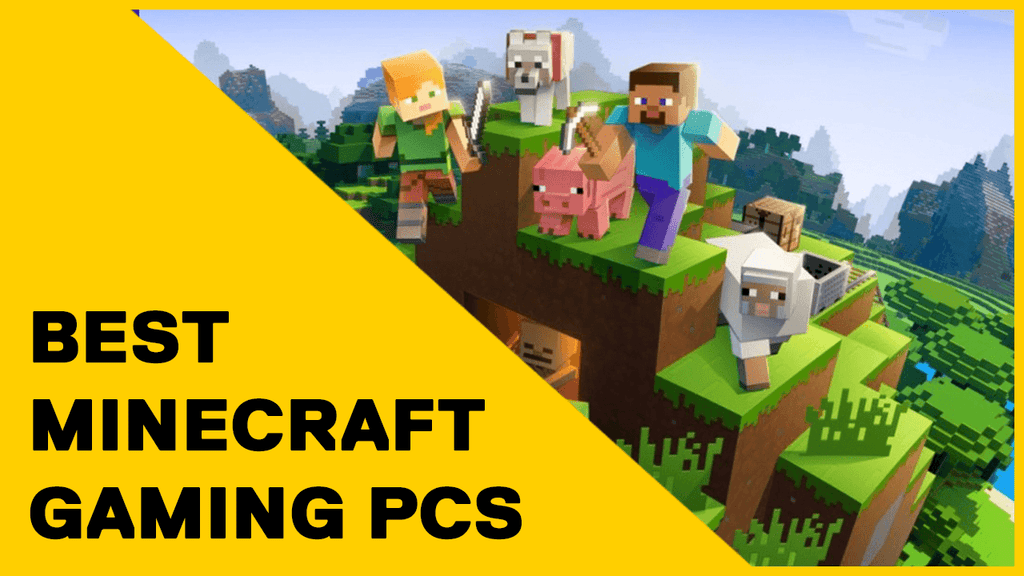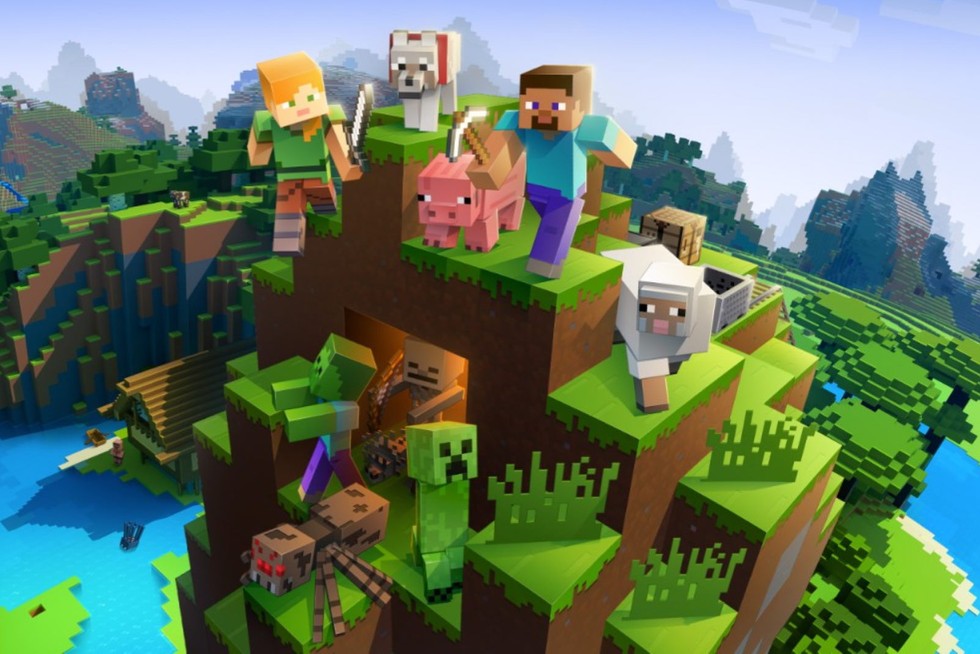
The Ultimate Guide to Building the Best Gaming PCs for Minecraft
![]() Craig Hume - MD @ Utopia
Craig Hume - MD @ Utopia
Published -
Introduction: Crafting your Perfect PC

- Minecraft is the biggest selling video game of all time.
Minecraft, the iconic sandbox game developed by Mojang, has become a cultural phenomenon since its inception. With its pixelated graphics and limitless creativity, players have the freedom to build, explore, and survive in a blocky, infinite game world. Whether battling Endermen in The End, crafting intricate redstone contraptions, or simply building your dream house, the game's performance can significantly enhance (or hinder) your experience. Choosing the best gaming PCs for Minecraft is pivotal in this regard.
Whether you're a casual player or a Minecraft enthusiast aiming to install high-end mods and shaders, your hardware can make all the difference. This guide will walk you through the optimal PC specifications for smooth Minecraft gameplay, ensuring you maximise your in-game adventures and experience the best with the best gaming PCs for Minecraft.
Optimal Gaming PC Specifications for Minecraft
Custom PC Build Recommendations:
Budget Minecraft Build:
Ideal for casual gamers who primarily play Vanilla Minecraft or with light modifications.
CPU: AMD Ryzen 5 5600G
GPU: Integrated Vega 8 Graphics (within the Ryzen 5600G)
RAM: 8GB DDR4 3000MHz or faster
Storage: 240GB SATA SSD
Motherboard: H520M chipset (with future upgrade paths)
Power Supply: 50W, 80 PLUS Bronze Certified
Case: A mid-tower case with good airflow
Brief Reasoning:
This build focuses on cost-efficiency, leveraging the integrated graphics of the Ryzen 5 5600G, which is sufficient for basic Minecraft gameplay. An SSD ensures faster load times, and the H520M motherboard offers potential for future upgrades.
Mid-Range Minecraft Build
For dedicated players aiming for a smoother experience, especially when using resource packs or playing on larger servers.
CPU: AMD Ryzen 5 5600
GPU: NVIDIA GTX 1660, 1660 Super or 1660 Ti GPU
RAM: 16GB DDR4 3200MHz
Storage: 500GB NVMe SSD
Motherboard: B550 chipset
Power Supply: 600W, 80 PLUS Gold Certified
Case: A mid-tower case with good airflow and some RGB elements for aesthetics
Brief Reasoning:
The Ryzen 5 5600 paired with the GTX 1660 Super provides a considerable performance bump, ensuring consistent frame rates in more demanding scenarios. Doubling the RAM helps with multitasking and larger Minecraft worlds, and the NVMe SSD further accelerates load times. The B550 motherboard supports PCIe 4.0, offering future-proofing.
High End Build
For enthusiasts wanting to push Minecraft to its limits with heavy mods, shaders, and high-resolution texture packs - upto 4k.
CPU: AMD Ryzen 7 5800X or Intel Core i7-12700K
GPU: NVIDIA GeForce RTX 3070 or equivalent
RAM: 32GB DDR4 3600MHz or faster
Storage: 1TB NVMe SSD (PCIe 4.0 supported for faster speeds)
Motherboard: X570 chipset (for AMD) or Z690 (for Intel)
Power Supply: 750W, 80 PLUS Gold or Platinum Certified
Cooling: A high-quality air or AIO liquid cooler
Case: A spacious mid-tower with premium airflow, tempered glass panelling, and RGB lighting
Brief Reasoning:
This enthusiast build is designed for the best possible Minecraft experience. The high-tier CPU and RTX GPU allow for ray-tracing capabilities and smooth performance even with the most demanding mods and shaders. 32GB RAM ensures optimal performance, especially with mod-heavy gameplay, and a 1TB NVMe SSD provides ample storage space for the game, mods, and other applications.
Additional Considerations:

Monitor Resolutions & Refresh Rates:
Minecraft's graphical demands can vary widely based on modifications, shaders, and in-game settings. Here's how different monitor specifications can affect your gameplay:
1080p (Full HD): Most mainstream and even budget PCs can run Minecraft smoothly at this resolution. It's the standard for many gamers and provides a balanced visual experience.
1440p (Quad HD): For those looking for a sharper visual experience, 1440p offers more pixel density. Mid-range to high-end builds are recommended for this resolution, especially if shaders and mods are in use.
4k (Ultra HD): For a crisp and detailed visual experience, nothing beats 4K. However, remember that running Minecraft at this resolution, especially with shaders, requires a high-end PC build.
Refresh Rates:
60Hz: Suitable for casual gameplay and can be achieved even with budget builds at 1080p.
144Hz and Above: For those seeking ultra-smooth gameplay. It's particularly noticeable when navigating fast-paced scenes or flying around in-game. A mid-range to high-end PC is recommended to achieve these refresh rates consistently.
Peripherals:
Gaming Mouse: While Minecraft isn't a high-paced FPS game, a gaming mouse can offer better precision, especially in PvP scenarios or intricate building tasks. Features like programmable buttons can also be handy for quick inventory management or executing commands.
Keyboard: A mechanical keyboard provides tactile feedback and faster response times, beneficial for activities like rapid block placement, combat, or executing game commands.
VR Headset: Minecraft has a VR mode that can be experienced with VR headsets like the Oculus Rift or HTC Vive. If you're looking to immerse yourself in the blocky worlds truly, ensure your PC build is VR-ready. If you are using an Oculus Quest 2 or above headset you will need a PC with a motherboard that supports USB-C.
Game Controllers: Some players prefer using game controllers, especially when playing on larger screens or TVs. While not necessary, it's an option worth considering for those who enjoy a console-like experience.
Gameplay Experience
Gameplay Experience:
Minecraft is a game of infinite possibilities, and the last thing you want is to have those possibilities limited by your hardware. Here's how having the right setup can amplify your Minecraft adventures:
1. Seamless Exploration:
Minecraft worlds are vast and loaded with diverse biomes, from dense jungles to towering mountains. A well-equipped PC ensures:
- Smooth loading of chunks, eliminating abrupt terrain pop-ins.
- Stable frame rates even when exploring new, ungenerated terrains.
2. Mod & Shader Performance:
Minecraft's modding community is one of the most vibrant and expansive in the gaming world. A powerful rig allows players to:
- Run heavy modpacks without performance hitches.
- Experience game-altering mods without stability issues.
- Enjoy visually stunning shaders without compromising on frame rates.
3. Multiplayer & Server Play:
Engaging with friends or joining vast servers can be demanding on your system, especially with many players, entities, and complex builds in one location. The right PC ensures:
- Reduced lag during peak server activities.
- Fluid interactions in large player gatherings or events.
- A better overall multiplayer experience, without frame drops during critical PvP moments or large-scale community events.
4. Enhanced Visual Experience:
Minecraft's simplistic graphics can be deceiving. With the right settings and enhancements, the game can be a visual treat.
- High-resolution texture packs bring details to life.
- Dynamic lighting and water effects make for mesmerizing sunrises, sunsets, and underwater adventures.
- Ray-tracing, available on high-end GPUs, brings realistic lighting, shadows, and reflections to the blocky world.
5. Future-Proofing & Game Updates:
Minecraft consistently receives updates, introducing new content, mechanics, and sometimes, increased system demands.
- Investing in a robust PC now means being ready for future game updates without needing frequent upgrades.
- Ensures compatibility with future mods or third-party software enhancements.
Frequently Asked Questions
1. Can Minecraft run on integrated graphics?
Yes, Minecraft can run on integrated graphics, especially for the base game without heavy mods or shaders. Modern CPUs from Intel and AMD come with integrated graphics capable of handling Minecraft at lower to medium settings. However, dedicated GPUs are recommended for better performance and higher graphical settings.
2. How much RAM do I need for Minecraft?
For standard gameplay, 4GB of RAM is sufficient. However, if you're planning on using mods, especially larger modpacks, 8GB is recommended. For heavy modding or using resource-intensive shaders, 16GB or more might be beneficial.
3. Is Minecraft more CPU or GPU-intensive?
Base Minecraft tends to be more CPU-intensive, especially when generating new chunks or handling many entities. However, once you start introducing shaders, high-resolution texture packs, and certain mods, the game can become significantly more GPU-intensive.
4. Why does Minecraft, with its blocky graphics, require good hardware for mods and shaders?
Despite its simplistic appearance, Minecraft's world is vast and dynamic. Shaders introduce real-time lighting, shadow, and water effects, which are graphically demanding. Similarly, mods can add complex mechanics, entities, and structures, which can strain both the CPU and GPU.
5. Can I play Minecraft in VR? Is there a specific hardware requirement?
Yes, Minecraft has a VR edition. For a smooth VR experience, you'll need a more powerful setup, especially in terms of the GPU. Ensure you have a VR-ready PC and a compatible VR headset like the Oculus Rift, HTC Vive, or Valve Index.
6. How do I ensure maximum FPS (Frames Per Second) while playing?
For maximum FPS:
- Ensure your drivers (especially GPU) are updated.
- Dedicate more RAM to Minecraft if using heavy mods.
- Adjust in-game settings: lower render distance, turn off smooth lighting, or reduce particle effects.
- Use optimization mods like OptiFine.
7. I'm experiencing lag during multiplayer sessions. Is it my PC's fault?
Not necessarily. While a good PC ensures smoother gameplay, multiplayer lag can often be attributed to server issues, internet connection speed, or the latency between you and the server. It's always good to check your hardware and network connection when troubleshooting lag.

Leave a comment